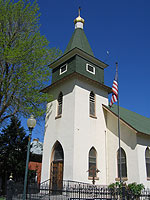Grant News
Got Preservation? (2006)
Father Joseph Hirsch describes the 108-year-old Holy Transfiguration of Christ Orthodox Cathedral as “a place where history stays alive.” A $200,000 preservation project supported by the State Historical Fund will make sure that it remains that way.
Built in 1898, the north Denver landmark originally served eastern European immigrants living in the Globeville neighborhood. Globeville began as an independent town platted on ranch land in 1889 by the Globe Smelting and Refining Company for its workers. Other refineries attracted additional residents, especially Volga Germans, Poles, Slovenians, Croatians, Russians, and Serbs. Community buildings and businesses, especially churches, reflected the national and religious heritage of each group. More importantly, these places eased the difficult process of cultural acclimation. By 1910, Globeville had been absorbed by Denver, but the ethnic communities centered around places of worship remained intact for several more decades.
“Globeville was a port of entry in Colorado for immigrants,” says Father Joseph. And the Holy Transfiguration of Christ Orthodox Cathedral, the first Orthodox church in Colorado, became a literal sanctuary for many of the newly arrived families.
The building’s architecture itself reflects the cultural assimilation families faced. Eastern Orthodox elements include the nave’s rounded dome ceiling representing the Dome of Heaven, the signature gold-leafed Russian-style onion dome cresting the front tower, and the rounded apse. Craftsmen incorporated typical rural American church elements as well, including Gothic pointed-arch windows and suggestions of tracery.
The golden dome is visible from Interstate 70, a highway that has played a major role in the church’s history. The thoroughfare’s construction forced many church-goers to relocate far away from their home base. As eastern European families moved away, the neighborhood lost its original identity. But the highway, once a destructive force, now provides convenient access to the church for a new wave of immigrants who live as far away as Aurora and Boulder. The way Father Joseph sees it, the church, which is located near the junction of I-70 and I-25, “is at the heart of Denver, where the two great arteries meet.”
Consecrated by the famed Bishop Tikhon (now St. Tikhon), the Holy Transfiguration of Christ Orthodox Cathedral is a rock of stability in north Denver. Having survived a minor earthquake and a major explosion at a nearby refinery, it seems as unshakeable as Bishop Tikhon himself, who became the Patriarch of Russia in 1917 and stood up to severe persecution by the Bolsheviks.
Today, the church faces a less dramatic, but more severe problem. Last year, Slater-Paul Architects conducted a Historic Building Assessment—supported in part by the State Historical Fund—which diagnosed the building with a condition known as “rising damp.” While the building remains structurally sound, continual “wicking” of water from an underground aquifer will eventually cause more damage than any minor earthquake or explosion.
The State Historical Fund has awarded a $155,000 grant to the church to repair water damage and mitigate the rising damp problem. Preservationists will excavate around the structure to the footings, conduct an archaeological assessment, and then redirect the water away from the foundation. Workers will also evaluate flooring, fix cracks in the exterior stucco, and repair the plaster walls inside.
The work will preserve the church, but more importantly, it will benefit the entire Globeville community. The church has been instrumental in reviving the neighborhood. It helped get the sidewalks, curbs, and gutters fixed, and it helped lure businesses, a health clinic, and ice rink. Like Father Joseph, neighbors see the church as the heart of Globeville.

